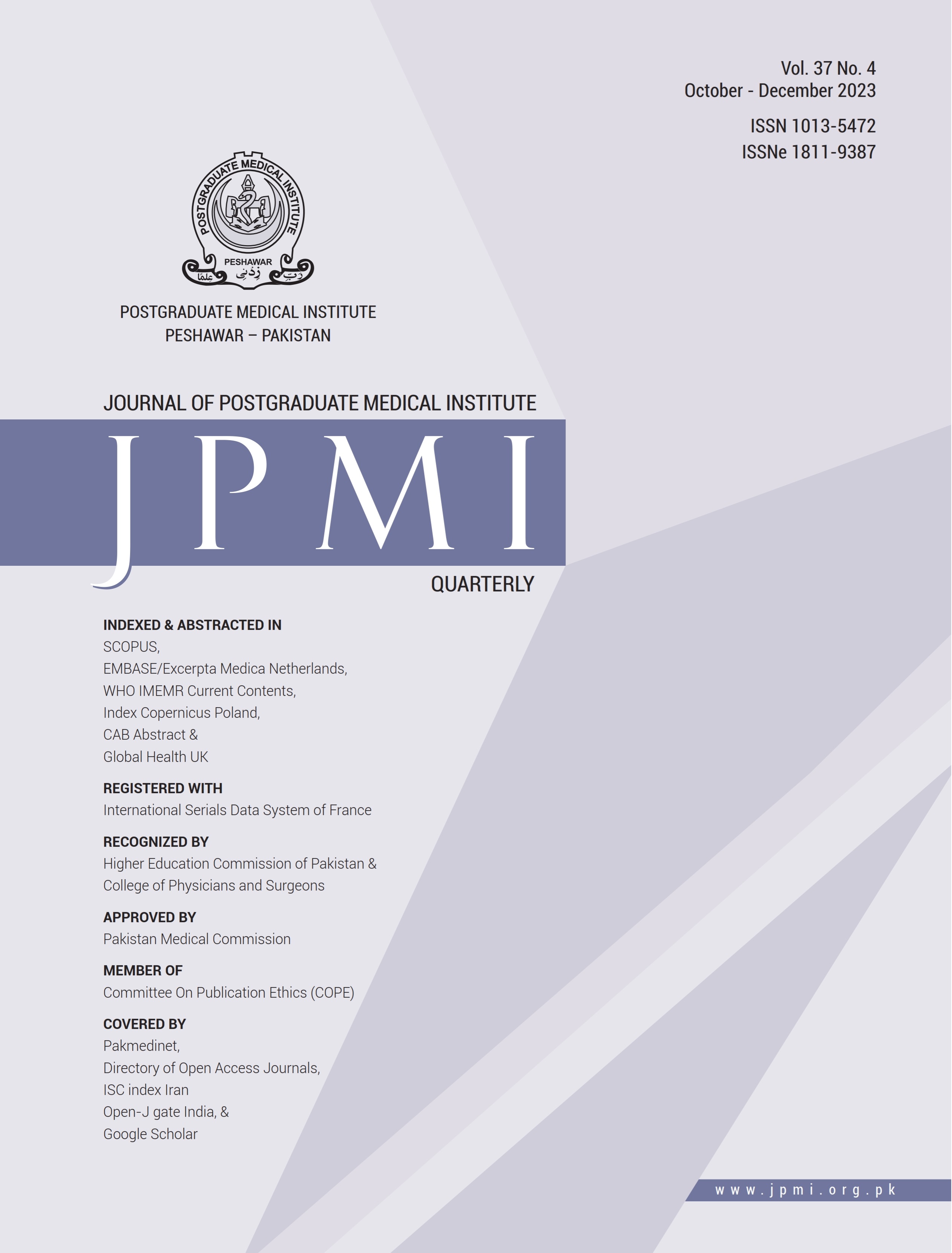THE POSITION OF HYOID BONE ON LATERAL CEPHALOGRAPHS IN VARIOUS VERTICAL FACIAL PATTERNS
Main Article Content
Abstract
Objective: To determine the position of hyoid bone on lateral cephalographs in various vertical facial patterns of orthodontic patients visiting Peshawar Dental College.
Methodology: This descriptive study was conducted at Department of Orthodontics, Peshawar Dental College. A total of 75 patients (46% male and 54% female) fulfilling the inclusion criteria were included through non-probability purposive sampling technique. These patients were divided into three groups of 25 patients each on the basis of FMA and Y axis on lateral cephalographs. Six angular, seven horizontal and seven vertical linear measurements were measured to evaluate the position of hyoid bone with its associated structures in different facial heights.
Results: One way ANOVA and post hoc Bonferroni tests showed a statistically significant difference between hypodivergent and hyperdivergent patterns for angular measurement H axis-MP (p=0.021*) and vertical linear measurement H-MP (p=0.025*). In horizontal linear measurements, H-Pog has shown a statistically significant difference (p=0.023*) between normo-divergent and hyperdivergent facial patterns.
Conclusions: Hyoid bone is positioned more infero-anterior in hyperdivergent subjects and superior-posterior in hypodivergent cases. The hyoid bone is positioned anteriorly in hyperdivergent subjects.
Article Details
Work published in JPMI is licensed under a
Creative Commons Attribution-NonCommercial 2.0 Generic License.
Authors are permitted and encouraged to post their work online (e.g., in institutional repositories or on their website) prior to and during the submission process, as it can lead to productive exchanges, as well as earlier and greater citation of published work.
References
Wang X, Wang C, Zhang S, Wang W, Li X, Gao S, Li K, Chen J, Wang H, Chen L, Shi J. Microstructure of the hyoid bone based on micro-computed tomography findings. Medicine (Baltimore). 2020;99(44):e22246.
Zhou X, Xiong X, Yan Z, Xiao C, Zheng Y, Wang J. Hyoid Bone Position in Patients with and without Temporomandibular Joint Osteoarthrosis: A Cone-Beam Computed Tomography and Cephalometric Analysis. Pain Res Manag. 2021;2021:4852683.
Soyoye OA, Otuyemi OD, Newman Nartey M. Cephalometric evaluation of hyoid bone position in subjects with different vertical dental patterns. Niger J Clin Pract. 2021;24(3):321-328.
Bilal R. Position of the hyoid bone in anteroposterior skeletal patterns. J Healthc Eng. 2021;2021:7130457.
Mortazavi S, Asghari-Moghaddam H, Dehghani M, Aboutorabzade M, Yaloodbardan B, Tohidi E, Hoseini-Zarch SH. Hyoid bone position in different facial skeletal patterns. J Clin Exp Dent 2018;10(4):e346.
Saeed A, Farid F, Shaheed S, Mushtaq N. Assessment of Hyoid bone position in different anteroposterior skeletal relationships: A Cross Sectional study. Pak Orthod j. 2021;13(1):19-24.
Chen W, Mou H, Qian Y, Qian L. Evaluation of the position and morphology of tongue and hyoid bone in skeletal Class II malocclusion based on cone beam computed tomography. BMC Oral Health. 2021;21(1):1-7.
Chen TP, Rodhisky F, Jiang SS, Cangialosi TJ. Hyoid Bone Position as an Etiological Factor in Mandibular Divergence and Morphology. Open J Orthop. 2022;12(1):10-25.
Adamidis IP, Spyropoulos MN. The effects of lymphadenoid hypertrophy on the position of the tongue, the mandible and the hyoid bone. Eur J Orthod. 1983;5(4):287-94.
Gundawar AP, Rawlani DM, Patil AS, Sabane A. Assessment and correlation of the position and orientation of the hyoid bone in Class I, Class II, and Class III Malocclusions. Int J Orthod Rehabil. 2019;10(4):161.
Acharya A, Mishra P, Shrestha RM. Pharyngeal airway space dimensions and hyoid bone position in various craniofacial morphologies. J Indian Orthod Soc. 2022;56(2):150-7.
Jiang C, Yi Y, Jiang C, Fang S, Wang J. Pharyngeal airway space and hyoid bone positioning after different orthognathic surgeries in skeletal class II patients. J Oral Maxillofac Surg. 2017;75(7):1482-90.
Wu S, Wang T, Kang X, Wang X, Jiao Y, Du X, Zou R. Hyoid bone position in subjects with different facial growth patterns of different dental ages. Cranio J Craniomandib Pract. 2021:1-7.
Jena AK, Duggal R. Hyoid bone position in subjects with different vertical jaw dysplasias. Angle Orthod. 2011;81(1):81-5.
Ertan Erdinc A, Dincer B, Sabah M. Evaluation of the position of the hyoid bone in relation to vertical facial development. J Clin Pediatr Dent. 2003;27(4):347-52.
Graber LW. Hyoid changes following orthopedic treatment of mandibular prognathism. Angle Orthod. 1978;48(1):33-8.
Schudy FF. Cant of the occlusal plane and axial inclinations of teeth. Angle Orthod. 1963;33(2):69-82.
Opdebeeck H, Bell WH, Eisenfeld J, Mishelevich D. Comparative study between the SFS and LFS rotation as a possible morphogenic mechanism. Am J Orthod. 1978;74(5):509-21.
Haralabakis NB, Toutountzakis NM, Yiagtzis SC. The hyoid bone position in adult individuals with open bite and normal occlusion. Eur J Orthod. 1993;15(4):265-71.


